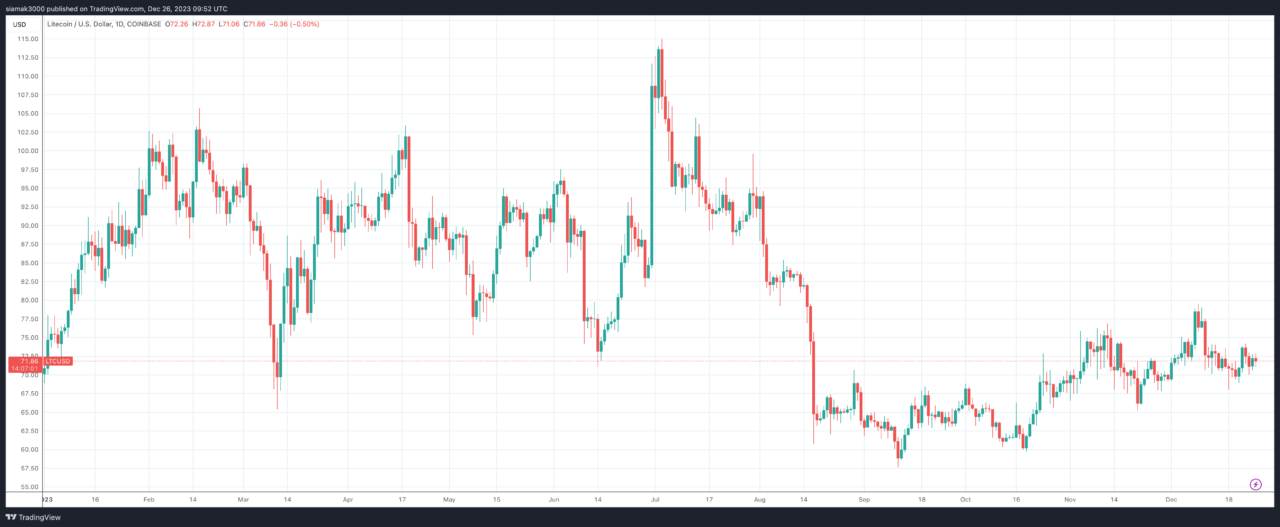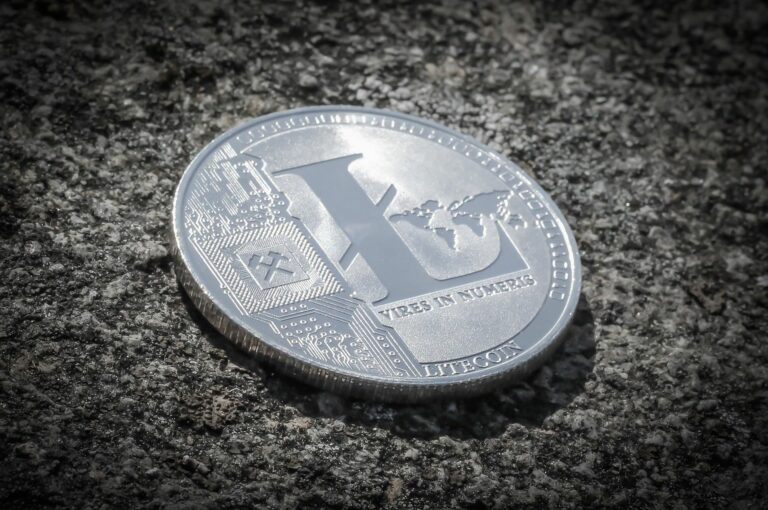Yesterday, Tuur Demeester, a prominent crypto analyst and researcher at Adamant Research, offered insights into Litecoin’s (LTC) performance in 2023, a year that saw the cryptocurrency market surge significantly, led by Bitcoin, which is up over 160% so far this year. Despite the overall market growth, Litecoin has shown relatively modest gains.

Litecoin’s Current Market Performance
- Recent Trading Price: As of the latest data, Litecoin is trading at approximately $72.00, marking a slight increase of 0.23% over the past 24 hours.
- Performance Over Time: In the last week, Litecoin has seen a 2.26% rise. Over the past thirty days, the increase has been a modest 0.77%, and year-to-date, Litecoin has grown by only 2.23%.
- Market Capitalization: With a market cap of $5.27 billion, Litecoin currently stands as the 20th most valuable cryptocurrency in the market.
Demeester’s Analysis of Litecoin’s Stagnation
Demeester points out several factors contributing to Litecoin’s lackluster performance:
- Inevitable Decline of Altcoins: Demeester begins by stating a broader perspective on altcoins, suggesting that eventually, every altcoin, including Litecoin, turns into what he calls a ‘zombiecoin’. He reminisces about Litecoin’s past status as the ‘silver’ to Bitcoin’s ‘gold’, indicating its former prominence in the crypto trading community.
- Forum Inactivity and Developer Disengagement: He notes the prolonged downtime of the Litecoin Talk forum, which appears to have gone unnoticed by developers and the community. This lack of attention, according to Demeester, signals a decline in engagement and interest within the Litecoin ecosystem.
- Delayed MWEB Integration: Demeester points out the absence of the Mimblewimble Extension Block (MWEB) integration with practical wallets for PC and mobile. He views this delay as a significant hindrance to Litecoin’s usability and appeal.
- Stagnation in Key Projects: Observing projects like OmniLite and LTC20, Demeester finds negligible activity and liquidity. He argues that the limited development in these projects fails to generate substantial interest or innovation.
- Decreasing Network Hashrate: He highlights the post-halving decline in Litecoin’s network hashrate as a potential sign of reduced miner engagement and network security concerns.
- Weakening Community Engagement: Demeester comments on the diminishing strength of the Litecoin community, with minimal social activity and interest mainly from long-term holders. He suggests this limits new investment and growth potential.
- Skepticism About Market Manipulation: Addressing the notion of market manipulation by ‘whales’, Demeester expresses doubt about significant manipulation in a market primarily sustained by long-standing users. He questions the growth potential in a project that lacks new user interest and investment.
Demeester also addresses the speculation about significant market manipulation by “whales” in Litecoin. He expresses skepticism about such manipulation in a market that is largely sustained by long-standing users, questioning the viability of growth in a project that lacks new user interest and investment influx.
Earlier this month, Tuur Demeester took to social media platform X to reflect on a Bitcoin report titled “How to Position for the Bitcoin Boom,” published by his firm, Adamant Research, in April 2023. He revisited the analysis and recommendations made in the report, offering a fresh perspective on Bitcoin’s current and future prospects.
In his detailed thread, Demeester delved into various aspects of Bitcoin, including its perceived undervaluation, the influence of macroeconomic factors, and the trend of nation-state adoption. He argued that Bitcoin is undervalued, especially when viewed as a long-term Store of Value. This assessment is based on the current macroeconomic climate, characterized by a downturn in traditional financial instruments like bonds and the resurgence of inflation. Demeester suggested that the market has not fully appreciated Bitcoin’s potential as a safeguard against economic instability and inflation.
He also examined how current macroeconomic trends are shaping a conducive environment for Bitcoin’s growth. Demeester pointed out the global economic over-indebtedness, predicting a shift in spending towards basic needs and a flight to reliable stores of value, which he believes will favor Bitcoin.
Discussing nation-state adoption, Demeester anticipated a gradual yet consistent integration of Bitcoin into national financial strategies. He envisioned scenarios where central banks might use Bitcoin to bolster their balance sheets, indicating a higher level of governmental recognition of Bitcoin’s utility and value.
On investment strategies, Demeester weighed the benefits of lump-sum investing against dollar-cost averaging and proposed various allocation strategies, ranging from conservative hedging to aggressive retirement planning.
Addressing Bitcoin custody and security, Demeester explored the complexities involved, discussing the trade-offs between different methods like single private key storage, multi-signature self-custody, third-party custodians, and his preferred method of Collaborative Custody. This approach, he advocated, strikes a balance between ensuring security and maintaining control.
Featured Image via Pixabay









